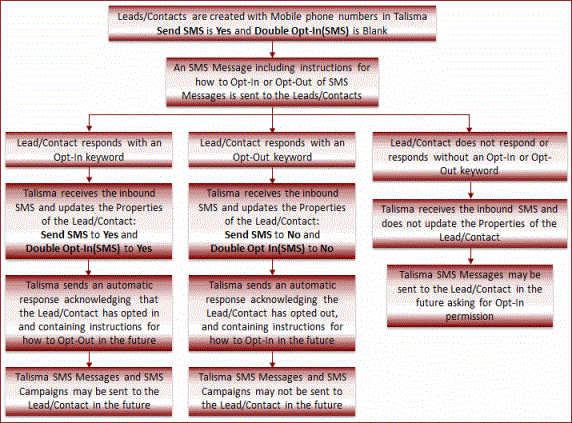|
Note • To work with the Double Opt-In feature, your organization must purchase the Talisma SMS license. • The Double Opt-In feature is applicable only for the Lead and Contact Objects. |
Double Opt-In is a method of requesting a response from customers to subscribe or unsubscribe from receiving SMS Campaigns from an organization.
SMS Double Opt-In is a compliance requirement that is applicable especially in North America. Organizations use the Double Opt-In functionality to ensure that SMS messages are sent only to those customers who have confirmed to receive SMS messages. If a customer Opts-Out from receiving SMS messages, the organization stops sending SMS messages to the customer. This helps organization to identify the targets for an SMS Campaign and send SMS messages only to them.
The value in the Double Opt-In(SMS) Property determines whether a Contact or Lead has Opted-In or Opted-Out from receiving SMS messages from an organization. This enables organizations to meet the SMS Double Opt-In compliance requirement for sending SMS messages to their customers.
To implement the Double Opt-In functionality in Talisma, organization must configure the Opt-In and Opt-Out keywords in Talisma, which is used in SMS Templates to send SMS Campaigns to Targets (Leads or Contacts). Based on the response received from the mobile number of a Target the Double Opt-In(SMS) Property is updated for the Lead and Contact in Talisma.
For information on the Opt-In and Opt-Out keywords that are used in SMS Templates, your administrator must see Installation Manager Help.
For information on creating SMS Templates for the Opt-In and Opt-Out SMS Messages, see Template Tabs and Properties.
For information on the behavior of the Send SMS and Double Opt-In(SMS) see, Behavior of the Send SMS and Double Opt-In(SMS) Properties.
The following graphic depicts the process flow for the Double Opt-In functionality in Talisma:

Process Flow for the Double Opt-In Functionality in Talisma
|
Note For the customers in North America, the above process flow, also referred to as Program details, is tested by the carriers (ATT, Verizon, etc.) in order to obtain a Short Code approval. |
For a usage scenario to work with the Double Opt-In functionality, see Usage Scenario to Work with the Double Opt-In Functionality.
|
Note • In Talisma, when an Opt-In or Opt-Out keyword is received from a Contact or Lead in a response SMS, it is applicable for sending all SMS from Talisma irrespective of the Campaign or Event for which the SMS message was sent. That is, a Contact or a Lead cannot choose to receive SMS Messages only from a specific Campaign, Event, Campus, or Program. • The Double Opt-In feature is applicable only for the Mobile Property of the Lead and Contact Objects. Further, the Double Opt-In feature is applicable only on the default Relationship of the Contact and Lead Objects, where the Lead Object is available when Talisma Higher Education Foundation is installed. As a result, the Send SMS and Double Opt-In(SMS) Properties of the Contact and its associated Leads will have the same value if they share the same Mobile number. For more information, see Behavior of the Send SMS and Double Opt-In(SMS) Properties. • A Talisma Client User can send an SMS message to the mobile number of a Lead or Contact from the Table View or Item View if the Send SMS Property is set to Yes. However, to send SMS Messages using a Campaign, the Talisma Client User can configure a Filter with the Send SMS and Double Opt-In(SMS) Properties as Filter conditions. If an emergency broadcast SMS message must be sent to Leads or Contacts in Talisma, a Talisma Client User can configure an SMS Campaign and ignore the Send SMS and Double Opt-In(SMS) Properties in the Filter conditions. For more information on configuring a Campaign to send SMS Messages to Contacts or Leads using the Double Opt-In functionality, see Usage Scenario to Work with the Double Opt-In Functionality. • Some aspects of the Double Opt-In feature depend on the default SMS service providers (Clickatell, Valuefirst, and SMS-Magic). Refer the service provider's product documentation before configuring the feature. |